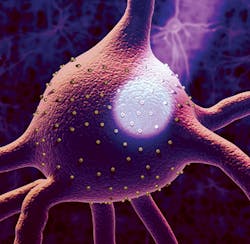OPTOGENETICS: Noninvasive optogenetics potentially promising for human applications
Optogenetics, which lets scientists control brain activity by shining light on neurons, involves light-sensitive proteins (to suppress or stimulate signals within cells) and—traditionally—a light source implanted in the brain. But a new molecule is the first to enable use of noninvasive light.
Developed by engineers at MIT (Cambridge, MA), the "Jaws" protein enables long-term studies by allowing the light source to be positioned outside the skull.1 The approach also allows a larger volume of tissue to be influenced at once. The development is particularly exciting because, as the researchers explain, it could eventually allow treatment of epilepsy and other neurological disorders, potentially including vision impairment, in humans.
In optogenetics, neurons to be studied must be genetically engineered to produce light-sensitive proteins known as opsins, which are channels or pumps that influence electrical activity by controlling the flow of ions in or out of cells. Implanted light sources can not only be difficult to insert, but also incompatible with many studies—for instance, of development, during which the brain changes size; of neurodegenerative disorders, during which the implant can interact with brain physiology; and of chronic disease, which requires long-term monitoring.
Engineering the opsins
Many organisms use opsins to detect light and react to their environment, and most of the natural opsins now used for optogenetics respond best to blue or green light. But these wavelengths do not penetrate as deeply into tissue as red. MIT researchers had previously identified two light-sensitive chloride ion pumps that respond to red, but the photocurrent they induced was not sufficiently strong for control.
Led by Ed Boyden, an associate professor of biological engineering and brain and cognitive sciences, graduate student Amy Chuong set out to improve the photocurrent by looking for relatives of these proteins and testing their electrical activity. She then engineered one of these relatives by making many different mutants: Jaws retained its red-light sensitivity, but had a photocurrent strong enough to shut down neural activity.
Using this opsin, Chuong and colleagues were able to control neuronal activity as deep as 3 mm in the mouse brain with a light source outside the head. They say the suppression was just as effective as that of existing silencers that rely on other colors of light delivered using invasive illumination.
A key advantage to this opsin is that it could enable optogenetic studies of animals with larger brains, says Garret Stuber, an assistant professor of psychiatry and cell biology and physiology at the University of North Carolina at Chapel Hill. "In animals with larger brains, people have had difficulty getting behavior effects with optogenetics, and one possible reason is that not enough of the tissue is being inhibited," he says. "This could potentially alleviate that."
RP treatment?
Working with researchers at the Friedrich Miescher Institute for Biomedical Research in Switzerland, the MIT team tested Jaws's ability to restore the light sensitivity of retinal cells called cones. In people with retinitis pigmentosa (RP), cones slowly atrophy, eventually causing blindness.
Miescher Institute scientists Botond Roska and Volker Busskamp had previously shown that some vision can be restored in mice by engineering cone cells to express light-sensitive proteins. The new paper describes how the pair tested Jaws in the mouse retina. They found that the new protein more closely resembles the eye's natural opsins and offers a greater range of light sensitivity, making it potentially more useful for treating RP.
Boyden advises, though, that "Since these molecules come from species other than humans, many studies must be done to evaluate their safety and efficacy in the context of treatment."
1. A. S. Chuong et al., Nature Neurosci., doi:10.1038/nn.3752 (2014).

